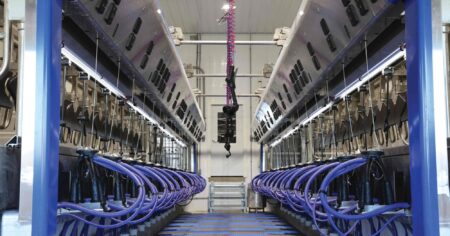When input prices are high and crop prices are low, optimizing every pass across the field helps keep budgets in the black. While nozzle choice and maintenance may seem like small pieces of a weed management plan, they can offer impactful returns.
“If you know you’re using a good product but have weed escapes, your nozzles are definitely an easy thing to look at,” says Austin Weiss, a staff product application specialist at Syngenta.
Common Nozzle Options
A fungicide application’s ideal nozzle may differ from a pre-emergence herbicide application’s preferred option. In a perfect world, farmers would optimize their nozzles for each pass. Realistically, many farmers want a one-size-fits-all option.
Each nozzle option offers different spray directions and droplet sizes.
Flat Fan Nozzle
The standard flat fan nozzle, used in most agricultural operations, can cover a large area at faster speeds. These nozzles produce triangular spray patterns, with more liquid distributed within the fans’ centers. Flat fan nozzles most commonly come in 80° or 110°tips, referring to the size of the spray fan. Droplet sizes can vary across the fan.
To create a uniform application, Purdue University Extension recommends overlapping spray patterns by at least 50%.
Angled Fan Nozzle
These nozzles spray product at an angle rather than straight down, as does a standard flat fan nozzle. The 3D90 from Syngenta, for example, is set at 55°, improving penetration into the plant canopy and reducing drift.
“With this, you’re getting a 90% reduction in driftable fine [droplets], more of that product actually ends up on the ground or in contact with the plant,” Weiss says.
Dual Fan Nozzle
Similar to an angled fan nozzle, this option produces two streams of product. These nozzles come in symmetrical and asymmetrical formations, which can help with correct product placement. The dual spray can help improve spray coverage and canopy penetration.
Droplet Distinction
Sprayer pressure, nozzle choice, and product chemistry all impact droplet size, which can range from 50 to 800 microns. The perfect droplet size is a bit like the Goldilocks problem: Too-small droplets are prone to drift, while too-large droplets are less likely to stick to their intended targets.
“If we’re spraying and we see really small droplets, that’s a concern because that product is liable to not get where we want it to go,” says Steven Fredericks, a senior research engineer at WinField United. “Really big droplets are going to land, but they might bounce or roll off the canopy.”
When developing products and spray guidelines, Winfield United aims for droplets in the 300-to-400-micron range.
Noah Rohlfing
Nozzle Maintenance
Don’t forget nozzles after placing them on the sprayer boom. Wear and tear can lead to disruptions in the spray fan, causing uneven product distribution. Products formulated with clay particles, as well as dirt and debris, can also cause blockages.
Often, internal rubber gaskets and worn edges can cause inconsistent application. Because wear often happens inside the nozzle and can’t be seen, Weiss recommends running water through the sprayer at the start of each year. If wear is evident, nozzles are relatively cheap and easy to replace.
“Checking that everything is working properly can really go a long way,” Weiss says.
Water-sensitive papers can help evaluate nozzle performance. The cards, which change color when wet, can be laid in the field to evaluate spray coverage and canopy penetration.
“You can fill your sprayer with water and drive over these to see what gets covered, or you can lay them out before doing a product application to see how many of the droplets make it down to the soil,” Weiss says.
In-Field Considerations
Truly optimizing spray applications goes beyond nozzle choice. Sprayer pressure, product selection, weather conditions, and more can all impact herbicide application efficiency. Finding the balance that works on your farm is key.
The herbicide product label should offer guidelines to optimize applications; most outline spray volume and nozzle recommendations. Labels should be read each year, especially as new EPA endangered species regulations take effect.
“If I’ve sprayed the same chemical multiple years, I might assume what I knew last year I still know this year,” says Ken Sauder, a region manager for Precision Planting. “But, chemical companies can change the labels, and if I don’t read the label, I won’t know their recommendations have changed.”
Why Bother?
U.S. farmers spent $21.3 billion on agricultural chemicals in 2022, the National Agricultural Statistics Service reported. While input prices rise, herbicide resistance and environmental concerns continue to challenge farmers.
A holistic optimized weed control strategy can help farmers mitigate the risk of lost product while saving time and money.
“Make sure you’re optimizing your formulation,” says King Nelson, a formulation chemist for Syngenta.
“Then, make sure you’re applying that formulation in the best way possible, so you can apply as little as you need to. Instead of having to do two passes, maybe you can get away with fewer passes and less product.”
An Adjuvant Advantage?
Adjuvants have gained popularity as farmers look to improve herbicide applications. These products aim to improve efficiency by changing the way herbicides perform.
Many drift-reduction adjuvants increase the viscosity of spray solutions, meaning a higher pressure may be necessary to achieve the desired product output. Adding an adjuvant may also affect droplet size and spray angles.
“Chemistries can give you more wiggle room,” says Austin Weiss, a staff product application specialist at Syngenta.
“For example, if you use a drift-reducing adjuvant, you might be able to achieve larger droplet sizes. On the other hand, by adding a retention aid while applying coarse droplets, those that might otherwise bounce off can stick to a leaf surface better, so you could get that drift control without sacrificing your product deposition on the plant.”
Visit the Weeds & Disease Playbook for more content like this.


:max_bytes(150000):strip_icc()/102745459-2000-39d4112adda8478b9a67c95a1adcec9e.jpg)
:max_bytes(150000):strip_icc()/grain_in_elevator-1-2000-4112e4b6ad3d496ab3f82ef7d069f16a.jpg)
:max_bytes(150000):strip_icc()/corn20pile2044958568734_93c6fe1041_c-327377b51fc6469788fde78d0a97dc85.jpg)


:max_bytes(150000):strip_icc()/moiseXVII-1249522339_Sprayer-f56d7563b7b04303872e53c2d59dc86a.jpg)
:max_bytes(150000):strip_icc()/SAMEtractor-2fbf8d22db7448bbb08a4d43140a67ca.jpg)

